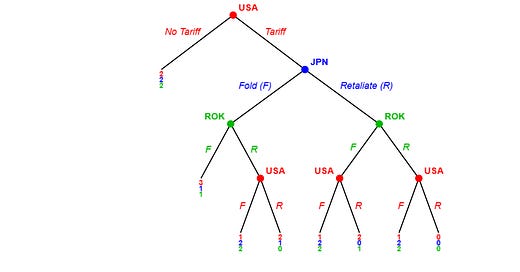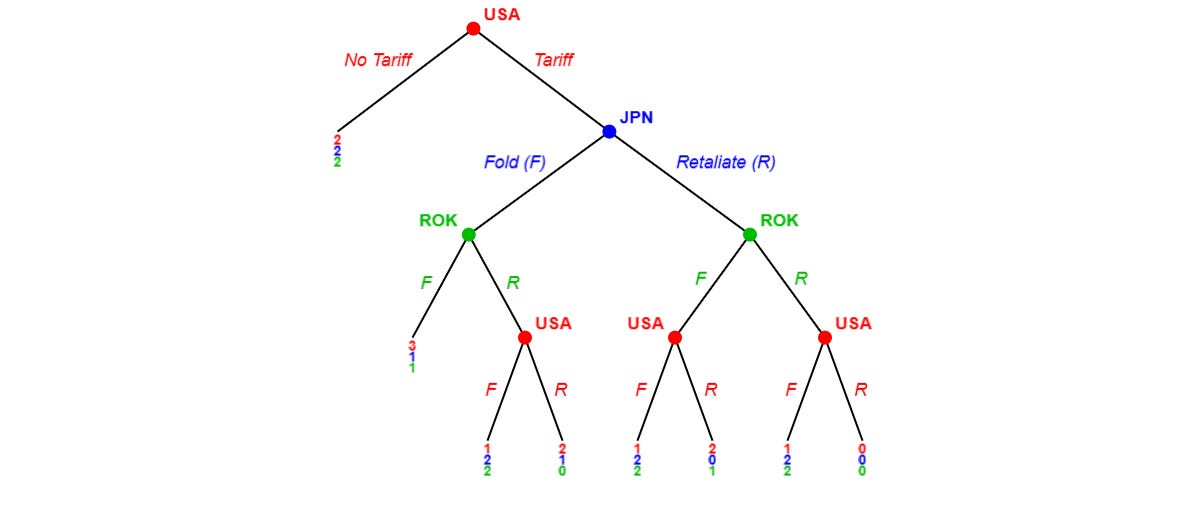Trade Wars as an Extensive-Form Game
Will Liberation Day Tariffs cause other countries to coordinate against the U.S.?
I was planning on releasing this on “Liberation Day” (April 2nd), but the announcement that China, Japan, and South Korea will coordinate their responses to U.S. tariffs scooped me. I was originally thinking of Canada and the European Union (EU) when I wrote this, but the logic applies to both sets of countries/unions. It seems like the Trump administration wants to fight a multi-front trade war.
I’ve always been interested in the intuitions simple games can give for complex issues in international relations, so I decided to model a mini-trade war between the U.S. and two of its East Asian allies. I used an extensive-form game to do this. It’s simplistic but as the saying goes, all models are wrong, but some are useful.
Trade war as a sequential game
The sequential game allows the U.S. to initiate (or not) tariffs on Japan and South Korea. Those countries can then either fold or retaliate (i.e. give concessions or implement their own trade restrictions). Each country has perfect information regarding the previous decisions. This makes sense, since both South Korea and Japan will know if the U.S. announced tariffs and what the other will do since they’re coordinating. If either or both South Korea and Japan retaliates, the U.S. can then respond to their retaliation by removing tariffs or increasing tariffs further. The game tree is below.
Before solving it, I want to justify my payoffs. There are 8 end nodes in this game, but only 5 cases. Let’s go case by case.
Case 1: U.S. doesn’t apply tariffs
Under the No Tariff action, everyone gets a good payoff. This is because tariffs are generally considered bad in economics. They raise prices for consumers, which includes people and industries consuming that good. For example, tariffing steel increases its cost and the cost of everything made with steel. Like cars. This leads to less demand for that good, which means less economic activity. Even layoffs in the industry you’re trying to support. Therefore, I assign the payoffs for the U.S., Japan, and Korea as (2, 2, 2), respectively.
Case 2: U.S. applies tariffs and both Japan and South Korea fold
U.S.
I’ll make a concession to the Trumpian point-of-view and make the US better off than in the No Tariff node. I don’t believe it, but I’ll go with it to be generous. It gets a payoff of 3.
Japan and South Korea
Both are hurt by their concessions, but tariffs are relaxed. They only lose one point of utility. They each get a payoff of 1.
Case 3: U.S. applies tariffs, but folds after at least 1 country retaliates
U.S.
The U.S. looks weak, so it loses a point of utility. It gets a payoff of 1.
Japan and South Korea
Japan and South Korea’s utility goes back to pre-tariff levels. Both get a payoff of 2.
Case 4: U.S. retaliates after one country retaliates and the other folds
U.S.
The retaliation if offset by the concessions of the folder. It’s payoff is steady at 2.
The folder
It folded, so it gets lenient treatment, but still loses a utility point for its concessions. It gets a payoff of 1.
The retaliator
The U.S. retaliates with more tariffs hurting it further. It loses two utility points to have a payoff of 0.
Case 5: U.S. Retaliates after both countries retaliate
Everyone is worse off. Trump doesn’t want other countries to retaliate since he threatens them with more retaliation. At some level he knows tariffs are bad when they’re on your country.
With the payoffs justified, the game is solvable with backward induction.
In the case where only one of South Korea or Japan folds, the U.S. gets a larger payoff from retaliating. Therefore, we can lop off the nodes where the U.S. folds after only one of the other countries folds.
Since the U.S. will always retaliate against a solo retaliator, the solo retaliator is always worse off by retaliating. So we can discard the end nodes where exactly one of Japan or South Korea retaliates.
In the case where the both South Korea and Japan retaliate, the U.S. is better off folding. So Japan and South Korea can both choose to fold or retaliate together. They get better payoffs by retaliating, so will choose to do that. Thus, their threat to coordinate their response is credible.
That takes us up to the first choice; whether the U.S. should apply tariffs or not. If it does, both Japan and South Korea will retaliate, making its best choice to fold. This yields a lower payoff than not applying tariffs. Therefore, the U.S. will choose not to tariff, which is the subgame perfect equilibrium. It turns out, the only winning move is not to play.
The solved tree is below.
Ok, but Trump seems pretty keen on tariffs
Although I tried to be generous to Trump’s perspective on tariffs in the payoffs, the game I set up says he shouldn’t put them into place. I probably don’t have his payoffs right; it is hard to divine the mind of someone you can’t comprehend.
His public statements are adamant that tariffs will revitalize American manufacturing (regardless of what Wall Street thinks), so my padding to the utility of tariffs for the U.S. is likely insufficient to explain his behavior. There is a chance he is bluffing, but the amount he has built up Liberation Day makes me skeptical. If he does nothing, he will look weak.1 It is possible he is putting himself in a position to look weak and wrecking the stock market to send a costly signal. Like removing the steering wheel in a game of chicken. However, I believe he genuinely thinks tariffs are good given forty years of public statements. In that case, Japan and South Korea’s best move is to retaliate. The same goes for Canada and the EU, along with any other targets.
What will a trade war mean?
This is beyond my simple game and into armchair economist territory. I’ll indulge myself anyways. South Korea and Japan will be pushed to trade more with China, which is what the gravity model of trade predicts. Canada and the EU will likely trade more with each other, and China too.
If the U.S. had focused trade restrictions on goods and industries critical to national security and worked with its allies to implement similar restrictions, it would have had a shot at decoupling China from supply chains critical to national security. Instead, Trump’s quixotic quest to balance the trade deficit is pushing America’s closest allies closer to China. America first is America alone.
Perhaps not to his base. I now honestly believe he could stand in the middle of 5th avenue and shoot someone and 30-40% of voters would be on board.






